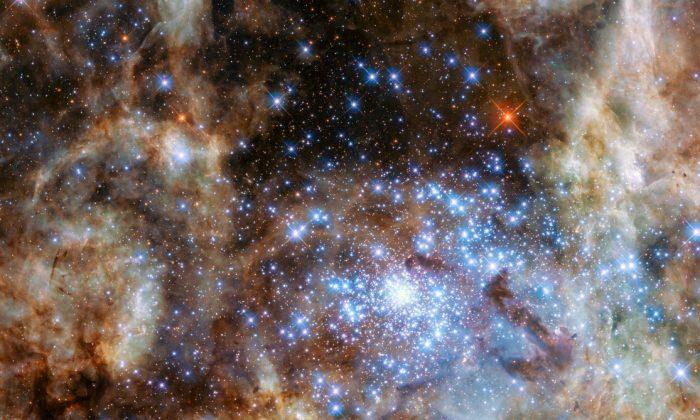Astronomers have identified nine massive stars that are more than 100 times the mass of the sun. The team made the discovery using the Hubble Space Telescope.
The discovery of the star cluster named R136 is the largest sample of very massive stars identified to date and has raised many new questions about the formation of massive stars.
The international team of scientists, led by researchers from the University of Sheffield, combined images taken with the Wide Field Camera 3 with the unprecedented ultraviolet spatial resolution of the Space Telescope Imaging Spectrograph (STIS) to successfully dissect the young star cluster in the ultraviolet for the first time.
R136 is only a few light-years across and is located in the Tarantula Nebula within the Large Magellanic Cloud about 170,000 light-years away. The young cluster hosts many extremely massive, hot, and luminous stars whose energy is mostly radiated in the ultraviolet—which is why the scientists probed the ultraviolet emission of the cluster.
As well as finding a total of nine very massive stars, more than 100 times more massive than the sun, the new study also revealed dozens of stars exceeding 50 solar masses.
The detected stars are not only extremely massive, but also exceptionally bright. Together the nine massive stars outshine the sun by a factor of 30 million.
“Once again, our work demonstrates that, despite being in orbit for over 25 years, there are some areas of science for which Hubble is still uniquely capable,” says Paul Crowther, a physics and astronomy professor at the University of Sheffield and lead author of the study.
“The ability to distinguish ultraviolet light from such an exceptionally crowded region into its component parts, resolving the signatures of individual stars, was only made possible with the instruments aboard Hubble.”
In 2010, Crowther and an international team of collaborators showed the existence of four stars within R136, each with over 150 times the mass of the sun. At that time the extreme properties of these stars came as a surprise as they exceeded the upper-mass limit for stars that was generally accepted at the time.
Now, this census, published in the Monthly Notices of the Royal Astronomical Society, shows there are five more stars with more than 100 solar masses in R136 raising many new questions about the formation of massive stars as the origin of these huge creations remains unclear.
“There have been suggestions that these monsters result from the merger of less extreme stars in close binary systems,” says Saida Caballero-Nieves, also from the University of Sheffield and coauthor of the study. “From what we know about the frequency of massive mergers, this scenario can’t account for all the really massive stars that we see in R136, so it would appear that such stars can originate from the star formation process.”
To find answers about the origin of these stars, the team will continue to analyze the datasets. An analysis of new optical STIS observations will also allow them to search for close binary systems in R136, which could produce massive black hole binaries that would ultimately merge, causing gravitational waves.
Despite the new discovery, the current record holder R136a1 does keep its place as the most massive star known in the universe at more than 250 solar masses.
This article was originally published by the University of Sheffield. Republished via Futurity.org under Creative Commons License 4.0.




Friends Read Free